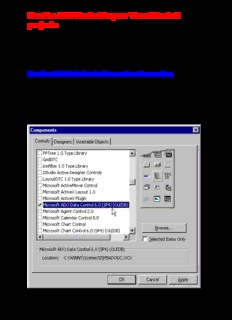
Using the ADO Control in your Visual Basic 6 projects PDF
Preview Using the ADO Control in your Visual Basic 6 projects
Using the ADO Control in your Visual Basic 6 projects Use the ADO Control in your Visual Basic 6 projects Aside from my Database book, I haven't done much writing concerning connection to a Database---and virtually nothing on ADO. In this article, I'd like to show you how you can connect to a Microsoft Database using the ADO Data Control and the ADO Data Grid. Use the ADO Data Control to create a Connection The first step in using the ADO Data Control to create a Connection to a database is to find the ADO Data Control. By default, the DAO Data Control is contained in the Visual Basic Toolbox, so you'll need to select Project- Components from the Visual Basic Menu Bar, and select the Microsoft ActiveX Data Control… If you click on the OK button, the ActiveX Data Control will then appear in the http://www.johnsmiley.com/cis18.notfree/Smiley017/Smiley017.htm (1 of 18)3/28/2004 11:54:24 AM Using the ADO Control in your Visual Basic 6 projects Visual Basic Toolbox… At this point, we may as well find the ADO DataGrid as well---we'll be needing it in just a few minutes to display the data retrieved from the Recordset (a virtual database table) that we'll be generating. Find the ADO DataGrid by selecting Project-Components and looking for Microsoft DataGrid Control… http://www.johnsmiley.com/cis18.notfree/Smiley017/Smiley017.htm (2 of 18)3/28/2004 11:54:24 AM Using the ADO Control in your Visual Basic 6 projects If we click on the OK button, the DataGrid will now be added to the Visual Basic Toolbox also… http://www.johnsmiley.com/cis18.notfree/Smiley017/Smiley017.htm (3 of 18)3/28/2004 11:54:24 AM Using the ADO Control in your Visual Basic 6 projects Now let's add both the Data Control and the DataGrid to our form… At this point, all we have is an empty DataGrid, and an uninitialized Data http://www.johnsmiley.com/cis18.notfree/Smiley017/Smiley017.htm (4 of 18)3/28/2004 11:54:24 AM Using the ADO Control in your Visual Basic 6 projects Control. Eventually (in just a few minutes), the Data Control will instantiate a Connection and Recordset, and the records from the Recordset will be 'bound' to the Data Grid. In fact, that's our next step---we need to bind the DataGrid to the Data Control, and we do that by bringing up the Properties Window for the DataGrid, and specifying its DataSource Property as Adodc1--the name of our Data Control… We still don't have a Connection or a Recordset built--but it won't be long. We need to provide values for the CommandType, the ConnectionString, and the RecordSource Properties of the Data Control. Coming up with values for these off the top of our head is too much trouble---Visual Basic will do it for us. All we need to do is click on the Custom Property of the Data Control… http://www.johnsmiley.com/cis18.notfree/Smiley017/Smiley017.htm (5 of 18)3/28/2004 11:54:24 AM Using the ADO Control in your Visual Basic 6 projects … and a Wizard to build the ConnectionString and the RecordSource Properties will appear… http://www.johnsmiley.com/cis18.notfree/Smiley017/Smiley017.htm (6 of 18)3/28/2004 11:54:24 AM Using the ADO Control in your Visual Basic 6 projects Click on the Build Button next to 'Use Connection String', and this window will appear… http://www.johnsmiley.com/cis18.notfree/Smiley017/Smiley017.htm (7 of 18)3/28/2004 11:54:24 AM Using the ADO Control in your Visual Basic 6 projects The names in this window may appear to be gibberish--but in order to connect to a Microsoft Access Database, we'll select Microsoft Jet 4.0 OLE DB Provider as our provider, and then click on the Next button. If we were connecting to an Oracle or a SQL Server database, we would select that type of Provider here. After clicking on the Next button, this window appear… http://www.johnsmiley.com/cis18.notfree/Smiley017/Smiley017.htm (8 of 18)3/28/2004 11:54:24 AM Using the ADO Control in your Visual Basic 6 projects We'll need to specify a database name in this window, and we're going to select a sample database that Microsoft ships with both Access and Visual Basic called BIBLIO.MDB (it contains data about books, authors, publishers and titles). For Access Databases, the User Name is 'Admin' by default, and there is no password. If we had selected an Oracle or SQL Server Provider, this window would look somewhat different, but the idea is the same. For now, let's find and select the BIBLIO.Mdb database using this window… http://www.johnsmiley.com/cis18.notfree/Smiley017/Smiley017.htm (9 of 18)3/28/2004 11:54:24 AM Using the ADO Control in your Visual Basic 6 projects then click on the Open button… http://www.johnsmiley.com/cis18.notfree/Smiley017/Smiley017.htm (10 of 18)3/28/2004 11:54:24 AM
Description: